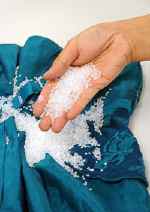SYNTHETIC fibers tend to make low-quality clothing. But one of the properties that makes nylon a poor choice of fabric for a shirt, namely its ability to attract and retain dirt and stains, is being exploited by a company that has developed a new laundry system. Its machine uses no more than a cup of water to wash each load of fabrics and uses much less energy than conventional devices. The system developed by Xeros, a spin-off from the University of Leeds, in England, uses thousands of tiny nylon beads each measuring a few millimeters across. These are placed inside the smaller of two concentric drums along with the dirty laundry, a squirt of detergent and a little water. As the drums rotate, the water wets the clothes and the detergent gets to work loosening the dirt. Then the nylon beads mop it up. The crystalline structure of the beads endows the surface of each with an electrical charge that attracts dirt. When the beads are heated in humid conditions to the temperature at which they switch from a crystalline to an amorphous structure, the dirt is drawn into the core of the bead, where it remains locked in place. The inner drum, containing the clothes and the beads, has a small slot in it. At the end of the washing cycle, the outer drum is halted and the beads fall through the slot; some 99.95% of them are collected. Because so little water is used and the warm beads help dry the laundry, less tumble drying is needed. An environmental consultancy commissioned by Xeros to test its system reckoned that its carbon footprint was 40% smaller than the most efficient existing systems for washing and drying laundry. The first machines to be built by Xeros will be aimed at commercial cleaners and designed to take loads of up to 20 kilograms. Customers will still be able to use the same stain treatments, bleaches, and fragrances that they use with traditional laundry systems. Nylon may be nasty to wear, but it scrubs up well inside a washing machine. Economist.com
